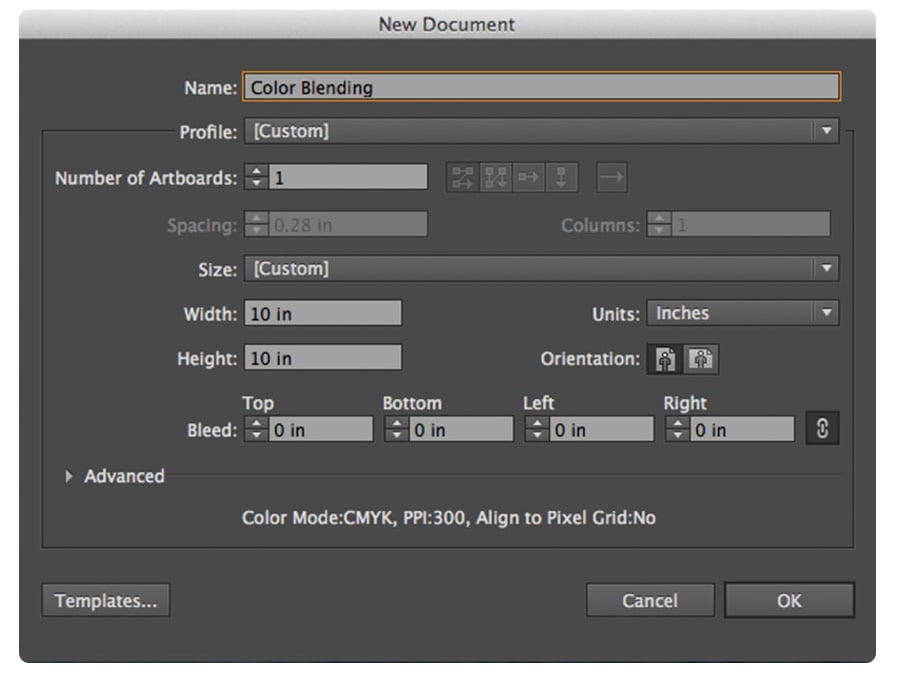
Quick Tip: How to Use the Blend Tool in Illustrator
There’s some phenomenal artwork out there right now that utilizes Adobe Illustrator’s blend tool in ways you might never have thought possible, especially when you’re just barely getting to know which tool does what in Illustrator’s Tools Palette.
 Let’s start by locating the blend tool and its settings, which can be found in a couple of different ways. The longer way is to navigate to it by navigating to Object > Blend > Blend Settings
Let’s start by locating the blend tool and its settings, which can be found in a couple of different ways. The longer way is to navigate to it by navigating to Object > Blend > Blend Settings
 Another way is to find it on the tools palette, near the bottom. It looks like a circle with a square tucked behind it. The keyboard shortcut for the Blend Tool is W (we’ll go into the tool itself more in a bit).
Another way is to find it on the tools palette, near the bottom. It looks like a circle with a square tucked behind it. The keyboard shortcut for the Blend Tool is W (we’ll go into the tool itself more in a bit).
 Now that you know how to find the blend tool, let’s start working with it. We’re going to start with some simple shapes. Navigate to your tool palette and select your ellipse tool.
Now that you know how to find the blend tool, let’s start working with it. We’re going to start with some simple shapes. Navigate to your tool palette and select your ellipse tool.
 Draw a circle (I’ve made mine 2” by 2”, but any size will do) near the left side of the artboard. Fill it with 2% gray. Next, switch to your selection tool (keyboard shortcut: V). We’re going to duplicate your circle. Hold down ALT, click and drag your circle to the right side of the artboard, and release. Once you’ve done that, you’ll have a cloned circle. Fill it with black.
Draw a circle (I’ve made mine 2” by 2”, but any size will do) near the left side of the artboard. Fill it with 2% gray. Next, switch to your selection tool (keyboard shortcut: V). We’re going to duplicate your circle. Hold down ALT, click and drag your circle to the right side of the artboard, and release. Once you’ve done that, you’ll have a cloned circle. Fill it with black.

 Let’s explore some basic blending options. Navigate to the Blend Tool’s settings in Object > Blend > Blend Options. In the small drop down menu, you’ll find three different types of blends. “Smooth color” gives you a smooth blend that resembles a gradient. “Specified steps” gives you the option of choosing a number of set color values between your starting and ending color (in this case, your 2% gray and black). “Specified distance” is similar to “specified steps,” but offers you the option of adding or removing space between each instance. As you add space, the number of value steps decreases. Decrease the space, and the value steps will increase. For this tutorial, select “specified steps,” and enter “2” into the box to the right. Click “OK.”
Wait. Nothing happened.
That’s because you still need to “make” the blend. Select both of your circles, then head to Object > Blend > Make.
Let’s explore some basic blending options. Navigate to the Blend Tool’s settings in Object > Blend > Blend Options. In the small drop down menu, you’ll find three different types of blends. “Smooth color” gives you a smooth blend that resembles a gradient. “Specified steps” gives you the option of choosing a number of set color values between your starting and ending color (in this case, your 2% gray and black). “Specified distance” is similar to “specified steps,” but offers you the option of adding or removing space between each instance. As you add space, the number of value steps decreases. Decrease the space, and the value steps will increase. For this tutorial, select “specified steps,” and enter “2” into the box to the right. Click “OK.”
Wait. Nothing happened.
That’s because you still need to “make” the blend. Select both of your circles, then head to Object > Blend > Make.
 The settings you just created are now applied, and you’ll see two value “steps” between your circles.
The settings you just created are now applied, and you’ll see two value “steps” between your circles.
 That’s one way to do it, but it’s definitely not the easiest. To cut time, use the tool palette (keyboard shortcut: W). Hold down ALT and click the center of the gray circle. This opens up the Blend Tool’s settings in a much more time-efficient way.
That’s one way to do it, but it’s definitely not the easiest. To cut time, use the tool palette (keyboard shortcut: W). Hold down ALT and click the center of the gray circle. This opens up the Blend Tool’s settings in a much more time-efficient way.
 From the drop down menu, select “Smooth Color.” Click “OK.” With your Blend Tool still active, click the center of the gray circle, then click the center of the black circle. Because you changed your settings to “smooth,” the blend now resembles a gradient (wait until you see what you can do with this setting later).
From the drop down menu, select “Smooth Color.” Click “OK.” With your Blend Tool still active, click the center of the gray circle, then click the center of the black circle. Because you changed your settings to “smooth,” the blend now resembles a gradient (wait until you see what you can do with this setting later).
 If you decide somewhere along the way that you’re not happy with a particular blend but it’s too late to use CMD+Z, there are couple of quick solutions you can employ. First, you can update the blend’s color palette. Simply double-clicking the item you want to change (this will enter isolation mode), select the item, then update the color by choosing an option from the swatches palette. This solution will work for any blend setting.
If you find that you need to completely remove a blend, but don’t want to lose the layout or shapes, you can use a nifty little menu option called “Release.” Select your item(s), then navigate to Object > Blend > Release.
If you decide somewhere along the way that you’re not happy with a particular blend but it’s too late to use CMD+Z, there are couple of quick solutions you can employ. First, you can update the blend’s color palette. Simply double-clicking the item you want to change (this will enter isolation mode), select the item, then update the color by choosing an option from the swatches palette. This solution will work for any blend setting.
If you find that you need to completely remove a blend, but don’t want to lose the layout or shapes, you can use a nifty little menu option called “Release.” Select your item(s), then navigate to Object > Blend > Release.
 Color and value aren’t the only tricks the Blend Tool has. It can also blend shapes-using the same techniques we covered above.
Color and value aren’t the only tricks the Blend Tool has. It can also blend shapes-using the same techniques we covered above.

 A quick warning for you when blending blacks. While you may not be able to see the difference between black and rich black (unless you’ve adjusted your settings to do so), you’ll find that they react very differently when used in a blend.
A quick warning for you when blending blacks. While you may not be able to see the difference between black and rich black (unless you’ve adjusted your settings to do so), you’ll find that they react very differently when used in a blend.
 In this example, the bottom option uses rich black and you can see the difference! While standard black (top) offers a wonderful transition from a pale rose, the rich black offers a much more saturated gradient.
In this example, the bottom option uses rich black and you can see the difference! While standard black (top) offers a wonderful transition from a pale rose, the rich black offers a much more saturated gradient.
 You can also blend multiple objects fairly quickly.
You can also blend multiple objects fairly quickly.
 Ready to stretch those new skills? Let’s create a unique blend that uses six different shapes. First, create a layout of circles like this one. Next, select your Blend Tool and click in the center of the top left circle. Click in the circle next to it, then click in the left circle in the middle row.
Ready to stretch those new skills? Let’s create a unique blend that uses six different shapes. First, create a layout of circles like this one. Next, select your Blend Tool and click in the center of the top left circle. Click in the circle next to it, then click in the left circle in the middle row.
 Continue on until you’ve completed each circle and have a zig-zag blend that looks like this one. Heads up-your Blend Tool will remain active unless you choose another tool, so anything else you click will be included in the blend! If this happens, keep calm and use CMD+Z (or the “Release” option we covered earlier).
Continue on until you’ve completed each circle and have a zig-zag blend that looks like this one. Heads up-your Blend Tool will remain active unless you choose another tool, so anything else you click will be included in the blend! If this happens, keep calm and use CMD+Z (or the “Release” option we covered earlier).
 Another great use for this wonderful tool is transitioning between multiple shapes. Using the same technique, try transitioning between three shapes, or from a simple shape, such as a circle, to a more complex shape, like a star.
Another great use for this wonderful tool is transitioning between multiple shapes. Using the same technique, try transitioning between three shapes, or from a simple shape, such as a circle, to a more complex shape, like a star.

 Finally, try using the blend tool to transition between several colors, or to create an illusion of depth, as in the example below.
Finally, try using the blend tool to transition between several colors, or to create an illusion of depth, as in the example below.

 As you spend more time exploring this tool’s capabilities, you’ll learn that it really adds some serious power to your workflow. Need to generate evenly-spaced values for an infographic? Need to create a smooth, metallic surface? Need to quickly create 3D items in a variety of colors? The Blend tool can do all of this…and a lot more.
As you spend more time exploring this tool’s capabilities, you’ll learn that it really adds some serious power to your workflow. Need to generate evenly-spaced values for an infographic? Need to create a smooth, metallic surface? Need to quickly create 3D items in a variety of colors? The Blend tool can do all of this…and a lot more.








Comments